List of Kereta Api Indonesia rolling stock classes. All are for 3 ft 6 in gauge railways unless otherwise stated. This list includes both operational and withdrawn classes.
Steam locomotives
Operational
| Class | Unit number | Image | Axles (AAR) | Axles (Whyte) | Builder | Power (hp) | Year built | Initial use | Status |
|---|---|---|---|---|---|---|---|---|---|
| B25 | 02 & 03 | .jpg.webp) |
B-1 | 0-4-2RT | 450 | 1902 | rack railway, branchline | Operational at Ambarawa Railway Museum | |
| B51 | 12 | 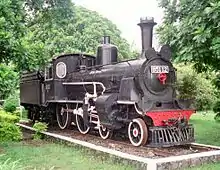 |
2-B | 4-4-0 | 415 | 1902 | mainline, regional | Operational at Ambarawa Railway Museum | |
| C12 | 18 | .jpg.webp) |
1-C | 2-6-0T | 350 | 1896 | shunter, branchline | Used for Sepur Kluthuk Jaladara excursion train at Surakarta | |
| D14 | 10 |  |
1-D-1 | 2-8-2T | 1187 | 1921 | mainline, freight | Used for Sepur Kluthuk Jaladara excursion train at Surakarta | |
| D52 | 099 (possibly renumbered 080) | .jpg.webp) |
1-D-1 | 2-8-2 | 1600 | 1952 | mainline | Stored at Purwosari station awaiting restoration | |
| E10 | 60 | .jpg.webp) |
E | 0-10-0RT | 750 | 1966 | mainline, rack railway, freight | Operational at Sawahlunto station, used for Mak Itam excursion train. | |
Diesel locomotives
3 ft 6 in gauge
| Diesel–mechanical | ||||||||
|---|---|---|---|---|---|---|---|---|
| Class | Unit number | Image | Axles | Builder | Power (hp) | Engine | Date | Initial use |
| B101 (Pelita 1) | 01 | 1A | 120 | Mercedes-Benz OM 352 | 1969 | shunter, experimental | ||
| Diesel–electric | ||||||||
| Class | Unit number | Image | Axles | Builder | Power (hp) | Engine | Year built | Initial use |
| A200 (Gajah Mada) | 01 | 1A | n/a | n/a | n/a | shunter, experimental[5] | ||
| B200 (20TDE) | 01-02 | B | 80 | n/a | 1961 | shunter | ||
| B200 (Bima Kunting 2) | 01 | B | 120 | Daimler-Benz M204 B | 1965 | shunter, experimental | ||
| B201 (Bima Kunting 3) | 01 |  |
B | 120 | Daimler-Benz M204 B | 1965 | shunter, experimental | |
| BB200 (EMD G8U6) | 01-35 | .jpg.webp) |
A1A-A1A | 875 | EMD 8-567C | 1957 | mainline | |
| BB201 (EMD G12U6) | 01-02 |  |
A1A-A1A | 1310 | EMD 12-567C | 1963 | mainline | |
| 03-11 | 1964 | |||||||
| BB202 (EMD G18U6) | 01-03 | .jpg.webp) |
A1A-A1A | 1100 | EMD 8-645E | 1967 | mainline | |
| 04-08 | 1971 | |||||||
| BB203 (GE U18A1A) | 01-11 |  |
A1A-A1A | 1500 | GE 7FDL-8 | 1977 | mainline | |
| 12-59 | 1983-1985 | |||||||
| BB204 (SLM HGm4/6) | 01-06 | .jpg.webp) |
Boz-2-Boz | 1230 | MTU 12V 396 TC 12 | 1982 | rack railway, freight, mainline | |
| 07-10 | 1983 | |||||||
| 11-17 | 1984-1993 | |||||||
| CC200 (GE-ALCO UM 106T) | 01-27 |  |
Co-2-Co | 1750 | ALCO 244E | 1953 | mainline | |
| CC201 (GE U18C) | 01-28 |  |
Co-Co | 1950 | GE 7FDL-8 | 1977 | mainline | |
| 29-38 | 1978 | |||||||
| 39-72 | 1983 | |||||||
| 73R-90R | Co-Co | 1950 | GE 7FDL-8 | 1989 | ||||
| 91-110 | Co-Co | 1950 | GE 7FDL-8 | 1991 | ||||
| 111R-120R | Co-Co | 1950 | GE 7FDL-8 | 1993 | ||||
| 121R-137R | 1998 | |||||||
| 138R-144R | Co-Co | 1950 | GE 7FDL-8 | 2004 | ||||
| CC202 (EMD G26MC-2U) | 01-15 |  |
Co-Co | 2250 | EMD 16-645E | 1986 | freight, mainline | |
| 16-30 | 1990 | |||||||
| 31-33 | 1995 | |||||||
| 34-37 | 2001 | |||||||
| 38-39 | 2002 | |||||||
| CC203 (GE U20C) | 01-14 | 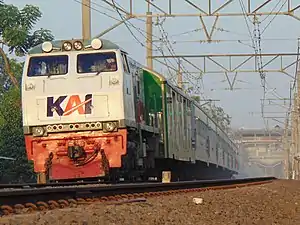 |
Co-Co | 2150 | GE 7FDL-8 | 1995 | mainline | |
| 15-27 | 2150 | GE 7FDL-8 | 1997 | |||||
| 28-30 | 1998 | |||||||
| 31-34 | 1999 | freight, mainline. Owned by paper pulp company PT Tanjungenim Lestari Pulp and Paper[6] | ||||||
| 35-37 | 2000 | mainline | ||||||
| 38-41 | 2002 | |||||||
| CC204 (GE C18MMi) | 01-04 |  |
Co-Co | 1950 | GE 7FDL-8 | 2003 | mainline | |
| 05-07 | 2005 | |||||||
| CC204 (GE C20EMP) | 08-17 |  |
Co-Co | 2150 | GE 7FDL-8 | 2006-2009 | freight, mainline | |
| 18-20 | 2010 | |||||||
| 21-37 | 2011 | |||||||
| CC205 (EMD GT38ACe) | 01-06 |  |
Co-Co | 2250 | EMD 8-710G3A | 2011 | freight, mainline | |
| 07-50 | 2013 | |||||||
| 51-55 | 2014 | |||||||
| 56-79[7] | 2021 | |||||||
| 80-91 | 2021 | |||||||
| CC206 (GE CM20EMP) | 01-100 |  |
Co-Co | 2250 | GE 7FDL-8 | 2013 | freight, mainline | |
| 101-139 | 2015 | |||||||
| 140-150 | 2016 | |||||||
| Diesel–hydraulic | ||||||||
| Class | Unit number | Image | Axles | Builder | Power (hp) | Engine | Year built | Initial use |
| Kebo Kuning | 01-02 | C | 100 | n/a | 1963 | shunter | ||
| C300 (LKM V30C) | 01-20 | .jpg.webp) |
C | 330 | Maybach Mercedes-Benz 836 B | 1957 | shunter, branchline | |
| D300 (Krupp M350D1) | 01-30 |  |
D | 340 | Maybach Mercedes-Benz 836 B | 1958 | shunter, branchline | |
| D301 (Krupp M350D2) | 01-80 |  |
D | 340 | Maybach Mercedes-Benz 836 B | 1962 | shunter, branchline, mainline (Madura) | |
| BB300 (Krupp M700BB) | 01-30 | .jpg.webp) |
B-B | 680 | Maybach Mercedes Benz 820 B | 1958 | shunter, branchline, mainline (Sumatra) | |
| BB301 (Krupp M1500BB) | 01-30 |  |
B-B | 1500 | MTU MD 12V 538 TB10 | 1964 | mainline | |
| 51-55 | 1970 | |||||||
| BB302 (Henschel DHG1000BB) | 01-06 |  |
B-B | 1200 (900 until 1998) | MTU 12V 493 TZ10 (MTU 12V 393 TZ10 prior 1998) | 1970 | mainline, regional | |
| BB303 (Henschel DHG1000BB) | 01-15 |  |
B-B | 1200 (1010 until 1998) | MTU 12V 493 TW10 | 1973 | mainline, regional | |
| 16-19 | 1200 | 1975 | ||||||
| 20-21 | 1976 | |||||||
| 22-47 | 1300 | 1980 | ||||||
| 38-42 | 1980 | |||||||
| 43-57 | 1984 | |||||||
| BB304 (Krupp M1500BB) | 01-11 |  |
B-B | 1550 | MTU 12V 652 TB11 | 1976 | mainline | |
| 12-25 | 1550 (BB304 23R has 1850 hp after repowered in 2010) | MTU 12V 652 TB11 and MTU 12V 4000 R41 (For BB304 23R) | 1984 | |||||
| BB305 | 01 |  |
B-B | 335 | Komatsu-Cummins NRTD-6-B1 | 1976 | shunter. Owned by cement company Semen Nusantara (then Solusi Bangun Indonesia)[8] | |
| BB305 (Ldh1500BB) | 01-03 | .jpg.webp) |
B-B | 1550 | MTU 12V 65 TB11 | 1982 | freight, mainline. Owned by paper company Kertas Leces[9] | |
| BB305 (BB1500HV) | 04-06 | .jpg.webp) |
B-B | 1550 | MTU 12V 652 TB11 | 1984 | freight, mainline. Owned by paper company Kertas Leces[11] | |
| BB306 (Henschel DHG800BB) | 01-22 |  |
B-B | 900 | MTU 8V 396 TC12 | 1984 | mainline, regional | |
| CC300 | 01-05 |  |
Co-Co | 2500 | Caterpillar 3512B HD | 2012–2014 | mainline. Owned by Directorate-General of Railways, Ministry of Transportation[12] | |
| DD55 (JNR DD13) |
12 |  |
B-B | 1000 | DMF31SB (2 units) | 1974 (built), 2006 (import) | freight, mainline, construction | |
750 mm gauge
| Diesel–hydraulic | ||||||||
|---|---|---|---|---|---|---|---|---|
| Class | Unit number | Image | Axles | Builder | Power (hp) | Engine | Date | Initial use |
| C301 | 01-08 |  |
C | 260 | GM-8V 71 NGO | 1972 | mainline (Aceh) | |
600 mm gauge
| Diesel–mechanical | ||||||||
|---|---|---|---|---|---|---|---|---|
| Class | Unit number | Image | Axles | Builder | Power (hp) | Engine | Date | Initial use |
| B100 (Bima Kunting 1) | 01 |  |
1A | 60 | Willys L134 | 1963 | branchline, experimental | |
Standard gauge
| Diesel–electric | ||||||||
|---|---|---|---|---|---|---|---|---|
| Class | Road no. | Image | Axles | Builder | Power (hp) | Engine | Date | Initial use |
| CC207 (DF4D) | 01 |  |
Co-Co | 3940 | 16V240ZJ* | 2023 | mainline, backup (KCIC)[13][14] | |
Internal combustion multiple units
Diesel multiple units
Hydraulic transmission
Reference[3]
| Class | Internal name | Image | Sets built | Cars per set | Builder | Power (hp) | Engine | Transmission | Year built | Remark |
|---|---|---|---|---|---|---|---|---|---|---|
| MADW300 (id) |
N/A | .jpg.webp) |
3 | 1 | 215 | GM 8V71[15] | Voith hydraulic Diwabus | 1962-63 | Single railcars, 1st class with baggage room, later downgraded to 3rd class, all retired, one preserved in Lempuyangan railway station | |
| MBW300 (id) |
N/A | 7 | 1 | 215 | GM 8V71[15] | Voith hydraulic Diwabus | 1962-63 | Single railcars, 2nd class, later downgraded to 3rd class, all retired | ||
| MCW301 (id) |
N/A | 12 | 2 | 180 | Shinko DMH17H[15] | Shinko TC-2A | 1976-1977 | 2-car set, one car with toilet and one without, but both are independent railcars that can run on its own, some converted into economy class cars and baggage cars. All retired | ||
| MCW302 Model 1978-1982 (id) |
N/A | .jpg.webp) |
84 | 1 | 1x290 | Shinko DMH17HSA | Shinko TCR2.5 | 1978-1982 | Single railcars, some were refurbished to Model 1987 spec in 1990s, some converted into economy class cars and baggage cars, most are retired | |
| MCW302 Model 1987 (id) |
MH101 |  |
28 | 1 | 1x280 | Cummins NT855 R5[15] | Voith T211r re. 3 | 1987 | Single railcars, most are retired | |
| Kereta Inspeksi 4 (id) |
MH201 |  |
1 | 5 | 4x280 | Cummins NT855 R5 | Voith T211r re. 3 | 2020 | 5-car set rebuilt from MCW302 series. Class change probably due to having one trailer car in the middle | |
| KRDI (id) |
MH201 |  |
12 | 4 | 2x517 | Cummins N14E-R3 JWAC[15] | Voith T211r re. 4 | 2008-2013 | 4-car set. INKA inspection trains were based on this class | |
| KRDI (id) |
MH201 |  |
1 | 2 | 1x375 | Cummins N14E-R | Voith T211r | 2008 | 2-car set built for standard gauge railway in Aceh (id) |
Electric transmission
Reference[3]
| Class | Internal name | Image | Sets built | Cars per set | Builder | Power (hp) | Engine | Traction Equipment | Year built | Remark |
|---|---|---|---|---|---|---|---|---|---|---|
| MCW104 (Railcar Perintis) | N/A | 1 |
|
60 | Detroit 8V-71 | n/a | ca. 1970 | Converted from former Jakarta EMU[16] | ||
| MCW200 | n/a | 1 |
|
250 | Kromhout (nl) 12TV120 | n/a | ca. 1970 | Converted from former Jakarta EMU[16] | ||
| KRDE (id) | ME201 |  |
5 | 5 | 1x1850 | Cummins QSK45[15] | Toshiba, Pindad | 2006-2009 | Rebuilt from BN-Holec EMU (id) 5-car sets | |
| C-KRDE (id) | ME201 |  |
5 | 5 | 1x1850 | Cummins QSK45[15] | Toshiba, Pindad | 2012 | Air conditioned, rebuilt from BN-Holec EMU (id) 5-car sets | |
| KRDE Push Pull (id) | ME202 | 2 | 5 | 1x1850 | Cummins (unknown model)[15] | Unknown | 2009 | Rebuilt from ABB-Hyundai EMU (id) 5-car sets | ||
| Railbus Kertalaya (id) | N/A |  |
1 | 3 | 1x400 | Cummins QSM11[15] | Unknown | 2009-2011 | Articulated 3-car set | |
| Railbus | N/A | 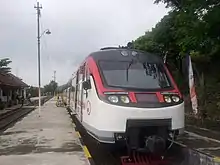 |
2 | 3 | 1x750 | Cummins QSK45[15] | Siemens Mobility, Pindad | 2009-2011 | Articulated 3-car sets, one set for Batara Kresna (id), and another one set for Lembah Anai (id) | |
| KRDE ARS Kualanamu | Woojin DEMU |  |
4 | 4 | 2x750 | Cummins SK19-R[17] | Woojin Industrial | 2012 | 4-car sets, operated by KAI Bandara for Kualanamu International Airport railway link | |
| KRDE ME204 | ME204 | 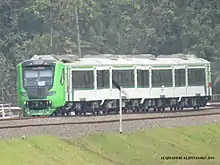 |
7 | 4 | 2x750 | Cummins QSK19-R | Bombardier Transportation (batch 1, TS1-3),
Medcom (Poland), Mitsubishi Electric (batch 2, TS 3-7) |
2018-2023 | 4-car sets, used for Airport Train in Padang, Surakarta, and Yogyakarta | |
| KRDE BPKASS | N/A | 3 | 3 | N/A | N/A | N/A | 2023 | 3-car sets built for standard gauge railway in South Sulawesi, operated under KAI-South Sulawesi Government JV |
Gasoline multiple units
Operated before independence, all withdrawn (presumably scrapped)
| Class | Internal name | Image | Number built | Builder | Power (hp) | Engine | Transmission | Build date | Remark |
|---|---|---|---|---|---|---|---|---|---|
| Motorwagen (MR) | N/A | 10 |
|
n/a | n/a | n/a | 1925-1928 | Operated by DSM (in North Sumatra), a precursor of KAI. Retired by 1942[18][19] |
Hybrid multiple units
| Class | Internal name | Image | Number built | Builder | Power (hp) | Engine | Transmission | Build date | Remark |
|---|---|---|---|---|---|---|---|---|---|
| Sarana Khusus Kereta Hibrida PNM | N/A |  |
1 | n/a | n/a | n/a | 2023 | Operated by Politeknik Negeri Madiun[20] |
Electric locomotives
All electric locomotives have been replaced by electric multiple units.[21]
System: 1.5 kV DC overhead, unless stated.
| Class | Unit number | Image | Axles | Builder/Manufacturer | Power (kW) | Year built | Remark |
|---|---|---|---|---|---|---|---|
| 3000 | 3001-3002 |  |
1-Do-1 | 800 | 1924 | Also known as BBC 0 series after independence[22] | |
| 3003-3004 | 1927 | ||||||
| 3100 | 3101 |  |
1-Bo+Bo-1 | 1,100 | 1924 | ||
| 3200 | 3201-3202 | _menggunakan_livery_biru..jpg.webp) |
1-Bo+Bo-1 | 765 | 1925 | Also known as WH 200 series after independence[22] | |
| 3203-3206 |  |
1928 | |||||
| 3300 | 3301-3303 |  |
Bo+Bo | 800 | 1930 | ||
| 4000 | 4001-4002 |  |
D | 115 | 1924 | 360 V DC battery locomotives |
Electric multiple units
Reference[21]
3 ft 6 in gauge rollingstock
System: 1.5 kV DC overhead & 750 V third rail
| Class | Internal name | Image | Units | In service | Cars per Set | Manufacturer | Power (kW) | Traction system | Remarks |
|---|---|---|---|---|---|---|---|---|---|
| ESS 100/200/400 series | N/A |   |
30 | 0 | 1, 2 | n/a | Resistor control | Delivered in 3 different configurations (trailer car, motor car, and motor car with baggage compartment). Trailer car classified as 700 series. Retired 1960s, converted to locomotive hauled coaches or DEMU | |
| MCW 500 (Rheostat EMU) | ED101 | 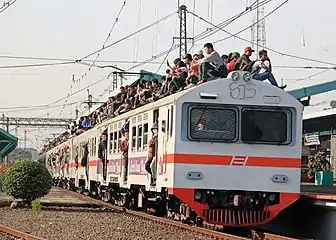  |
120 | 0 | 3, 4, 6 | 8x120
(4-car) |
Resistor control | retired 2013, scrapped or stored | |
| BN-Holec | EA101 |  |
128 | 0 | 4 | n/a | VVVF-GTO | retired 2013, some modified to become diesel commuter trains or Holec AC | |
| ABB Hyundai | N/A | 8 | 0 | 4 | n/a | VVVF-GTO | retired 2001, some modified to become diesel commuter trains in 2007-2009 as KRDE Arek Surokerto from 2009-2013, All units have been scrapped in July 2023 | ||
| Inka-Hitachi | EA102 |  |
24 | 0 | 4 | 8x170
(4-car) |
VVVF-GTO | retired 2013, scrapped or stored | |
| Toei 6000 series | ED102 |  |
72 | 0 | 4, 6, 8 | 2400 (6-car) | Resistor control | ex-Toei Mita Line rolling stock, operated by KAI Commuter 2000–2016, scrapped or stored. One head car preserved at Depok Depot | |
| 103 series | ED103 |  |
16 | 0 | 4, 8 | 440 (per motor car) | Resistor control | ex-JNR/JR East Musashino Line rolling stock, operated by KAI Commuter 2004–2016, all scrapped | |
| KRL-I | EA201 |  |
8 | 0 | 4 | n/a | VVVF-IGBT | operated by KAI Commuter 2001–2015, retired | |
| Tokyu 8000 series | ED201 |  |
24 | 12 | 12 | 520 (per motor car) | Chopper | ex-Tokyu Toyoko Line and Oimachi Line rolling stock, operated by KAI Commuter 2006–present | |
| Tokyu 8500 series | ED202 |  |
64 | 36 | 12 | 520 (per motor car) | Chopper | ex-Tokyu Den-en-toshi Line and Oimachi Line rolling stock, operated by KAI Commuter 2006–present | |
| Tōyō Rapid 1000 series | ED104 | 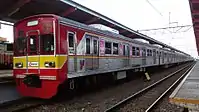 |
30 | 0 | 8 | 400 (per motor car) | Resistor control | ex-Tōyō Rapid Railway line rolling stock, operated by KAI Commuter 2007–2019, scrapped or stored | |
| Tokyo Metro 5000 series | ED105 |  |
30 | 0 | 8 | 400 (per motor car) | Resistor control | ex-Tokyo Metro Tōzai Line rolling stock, operated by KAI Commuter 2007– January 2020, scrapped or stored | |
| Tokyo Metro 7000 series | ED301 | 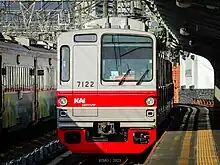 |
40 | 16 | 8 | 580 (per motor car) | Chopper | ex-Tokyo Metro Yūrakuchō Line rolling stock, operated by KAI Commuter 2011–present, 2 units decommissioned | |
| Tokyo Metro 05 series | ED302 |  |
80 | 40 | 8 | 640 (per motor car) | Chopper | ex-Tokyo Metro Tōzai Line rolling stock, operated by KAI Commuter 2010–present | |
| Tokyo Metro 6000 series | ED303 |  |
270 | 212 | 8, 10 | 580 (per motor car) | Chopper VVVF-IGBT |
ex-Tokyo Metro Chiyoda Line rolling stock, operated by KAI Commuter 2011–present | |
| 203 series | ED304 |  |
50 | 34 | 10, 12 | 3,000 (6M4T)
2,400 (4M4T) |
Chopper | ex-JNR/JR East Joban Line rolling stock, operated by KAI Commuter 2011–present | |
| KRL KfW i9000 | EA202 |  |
40 | 0 | 4, 8 | n/a | VVVF-IGBT | Financed by KfW,[25] operated by KAI Commuter 2011–2019 (Greater Jakarta) and 2021–present (Yogya-Solo) | |
| Holec AC | N/A | 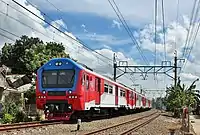 |
24 | 0 | 8 | n/a | VVVF-IGBT | former 1994-2001 KRL Ekonomi Holec trains retrofitted with AC, operated by KAI Commuter 2014–2015, currently stored. 2 head cars preserved in Madiun | |
| 205-0 series 205-5000 series |
N/A | 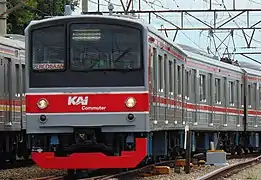
|
812 | 782 | 4, 8, 10, 12 | 480 (per motor car) | Resistor control (205-0) VVVF-IGBT (205-5000) |
205-0 ex-JR East Saikyo Line, Yokohama Line, Nambu Line, and Musashino Line rolling stock, operated by KAI Commuter 2013–present 205-5000 series ex-Musashino Line rolling stock, operated by KAI Commuter 2018–present | |
| Soekarno-Hatta ARL | EA203 | 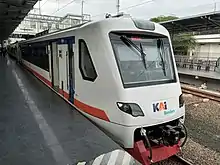 |
60 | 60 | 6 | 3,200 (4M2T)[27] | VVVF-IGBT | Operated by KAI Bandara for Soekarno-Hatta International Airport railway link, 2017–2022
Operated by KAI Commuter for Soekarno-Hatta International Airport railway link, 2023–present | |
| Palembang LRV | N/A | 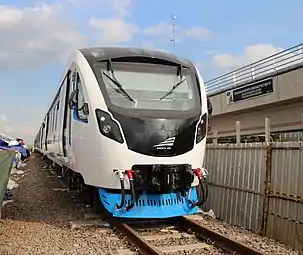 |
24 | 24 | 3 | 1,040 (2M1T)[29] | VVVF-IGBT | Operated by KAI for Palembang LRT, 750 V third rail, 2018–present | |
| INKA | N/A | 192 (not yet built) | 0 | 12 | TBA | VVVF (unknown type) | Operated by KAI Commuter (allocation TBD), planned to be delivered by 2024 |
Standard gauge rollingstock
System: 25 kV AC overhead & 750 V third rail
| Class | Internal name | Image | Sets built | In service | Cars per Set | Manufacturer | Power (kW) | Traction system | Remarks |
|---|---|---|---|---|---|---|---|---|---|
| Greater Jakarta LRV | N/A | 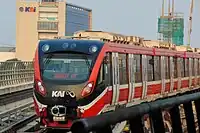 |
31 | 54[31] | 6 | 1,600 (4M2T)[33] | VVVF-IGBT | Operated by KAI for Greater Jakarta LRT, 750 V third rail, 2023–present | |
| CR400AF | KCIC400AF | 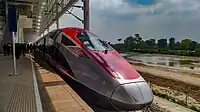 |
11 | 88 | 8 | n/a | VVVF-IGBT | Operated by KCIC (2nd tier subsidiary of KAI) for WHOOSH (Jakarta-Bandung HSR), 25 kV AC overhead, 2023–present. Also derived as inspection train (1 trainset). | |
Passenger coaches
| Class | Image | Type | Number built | Manufacturer | Max speed | Year built | Remark | |
|---|---|---|---|---|---|---|---|---|
| T1 Compartment Suites | .jpg.webp) |
T1 | 3 | 120 km/h | 2008 | Originally built as executive coaches in 2008. Converted by Manggarai Railway Workshop in 2023. Ex : (K1 0 08 03, K1 0 08 04, K1 0 08 07) | ||
| K1 Panoramic Series |  |
K1 | 2 | 2022 (1st generation), 2023 (2nd generation) | Converted from K1 1999, introduced in the late 2022.[35] | |||
| K1 Sleeper Luxury |  |
K1 Luxury 2 | 6 | 10 | 120 km/h | 2019 | Similar to K1/K3 Stainless Steel coaches but with "Sleeper Luxury" seating and amenities. | |
| K1 Luxury 1 | 4 | 2018 | ||||||
| K1/K3 2018 Stainless Steel |  |
K1 | 210 | 438 (38 sets)[36] | 120 km/h | 2018-2019 | The first passenger coaches made by INKA to feature stainless steel car body for the domestic market. | |
| K3 | 150 | |||||||
| M | 39 | |||||||
| P | 39 | |||||||
| K3 2017 Premium |  |
K3 | 48 | 66 (6 sets)[37] | 120 km/h | 2017 | Similar to K3 2016 New Image but with ample legrooms and reclining seats. | |
| K3 (Accessible) | 12 | |||||||
| MP3 | 6 | |||||||
| K3 2016 New Image |  |
K3 | 63 | 70 (7 sets) | 120 km/h | 2016 | Similar to K1 2016 New Image with a new style of economy class seating, abandoning the bench-style seating from prior K3 coaches. | |
| MP3 | 7 | |||||||
| K1 2016 New Image |  |
K1 | 81 | 99 (9 sets) | 120 km/h | 2016-2017 | A redesign from the older K1 coaches featuring continuous-style window arrangement similar to which on K1 "Argo Anggrek" coaches though with a different construction for ease of maintenance.[38] | |
| M | 9 | |||||||
| P | 9 | |||||||
| K3 AC "Kemenhub" |  |
K3 | 124 | 136 | 100 km/h | 2010-2014 | The first economy class coaches to feature built-in air conditioning units. These coaches can accommodate 80 passengers with 2-2 seating arrangements compared to older K3 coaches which feature 3-2 seating arrangements. Some units were designed to accommodate handicapped passengers.
In 2023, some coaches were refurbished with new interiors and seat. It also reduced its capacity from 80 to 72 in order to give more legroom. These refurbished coaches are allocated for KA Jayabaya and dubbed as "Ekonomi New Generation".[39] | |
| MP3 | 12 | |||||||
| K1 2009 "Airliner" |  |
K1 | 22 | 26 | 120 km/h | 2009-2010 | A redesign from the previous K1 coaches fitted out with airplane-style windows and interior design. Built for KA Gajayana (2009) and KA Argo Jati (2010) | |
| M1 | 2 | |||||||
| P | 2 | |||||||
| K1 2008 | K1 | 8 | 10 | 100 km/h | 2008 | Built for KA Argo Lawu. 3 units were converted into Compartment Suites Train (K1 0 08 03, K1 0 08 04, K1 0 08 07) | ||
| M1 | 1 | |||||||
| P | 1 | |||||||
| K3 2006 | K3 | 24 | 26 | 90 km/h | 2006 | The first economy class coaches built by INKA. Has standard economy class capacity of 106 seats.[40] | ||
| KMP3 | 2 | |||||||
| K1 2002 |  |
K1 | 41 | 49 | 100 km/h | 2002 | Some units were transferred to PT. KAI Divre 3 Palembang. | |
| M1 | 4 | |||||||
| P | 4 | |||||||
| K1 2001 |  |
K1 | 12 | 14 | 100 km/h | 2001 | Built for KA Gajayana. One unit (K1 0 01 08) designed to accommodate handicapped passengers. Some units were modified into Panoramic Leisure Train. | |
| M1 | 1 | |||||||
| P | 1 | |||||||
| K1 1999 | K1 | 17 | 19 | 100 km/h | 1999 | These executive class coaches are not featured with emergency windows. Currently, some units were refurbished into airplane-style windows and interior design by Manggarai railway workshop. One unit (K1 0 99 16) modified into Panoramic Leisure Train. | ||
| MP1 | 2 | |||||||
| K1 1998 |  |
K1 | 12 | 16 | 100 km/h | 1998 | Built for KA Argo Wilis. Some units were transferred to PT. KAI Divre 1 Medan. | |
| M1 | 2 | |||||||
| P | 2 | |||||||
| K1 JS-852 |  |
K1 | 41 | 55 | 120 km/h | 1997 and 2001 | A major improvement based on the JS-950/JB-250 featuring an all-new car body design with its wide body profile, continuous-style window arrangement, and a set of sliding plug doors. They are also equipped with CL243 (K9) bogies licensed from GEC Alstom, providing a smoother ride quality at higher speeds.[41] Currently stored. | |
| M1 | 7 | |||||||
| P | 7 | |||||||
| K1 JSO-751 | K1 | 10 | 12 | 120 km/h | 1996 | The executive class coaches which built for KA Argo Lawu in 1996. The passenger coaches were the results from the modification and overhaul of 1955 ABL-9000 series economy class set by INKA in 1995-1996. | ||
| M1 | 1 | |||||||
| P | 1 | |||||||
| K1 JS-950 / JB-250 |  |
K1 | 25 | 31 | 120 km/h | 1995 | INKA's first executive class coaches first launched for KA Argo Bromo and KA Argo Gede services in 1995. They feature a new bogie design, the NT-60 (K8) allowing them to run 120 km/h for the express services.[42] One unit (K1 0 95 04) modified into Priority Leisure Train, One dining coach (M1 0 95 01) refurbished into airplane-style windows. | |
| KM1 | 3 | |||||||
| P | 3 | |||||||
| K1 1984 |  |
1984 | The executive class coaches that PJKA bought from Astra Arad, Romania, to replace KA Bima Sleeper Class in 1984. Currently, some units were refurbished into airplane-style windows and interior design by Manggarai railway workshop. | |||||
| K2/K3 1978 | BW | 1978 | Business and economy class coaches that PJKA bought from Goša FOM in 1978 (K2 / K3-78700 series). Later some of the coaches were converted to executive class. The Yugoslav-built coaches has Görlitz (K7) bogie.[43][44] | |||||
| CW | ||||||||
| CFW | ||||||||
| DPW | ||||||||
| K2 1978 | BW | 34 | 1978 | Business class coaches that PJKA bought from Nippon Sharyo and other manufacturers in Japan in 1978 (BW-9100 / K2-78500 series). Later some of the coaches were converted to executive class. The Japanese-built business class coaches has NT-11 (K5) bogie.[45] | ||||
| K1 1966/1967 |  |
SAGW | 7 | 28[46] | 1966-1967 | SAGW and SBGW were first and second class sleeper coaches built for KA Bima. The trainset also consisted of dining coaches (FW/AC) and baggage cars with generator (DPW}. The sleeper coaches were refurbished and converted to regular executive class (K1) by INKA in 1989. | ||
| SBGW | 10 | |||||||
| FW/AC | 4 | |||||||
| DPW | 7 | |||||||
| CW/BW 9000 |   |
CW | 57 | 117[47] | 1964-1966 | Unique features of this series are the continuous ventilation grills above the windows, which later were removed later during refurbishment.[48] Some of the BW and CW coaches were converted to executive class (AW) coaches in 1978.[47] | ||
| BW | 35 | |||||||
| CFW | 25 | |||||||
| CW 9300 |  |
CW | 118[48] | 163 | 1964-1966 | Mostly retired. Unique features of this series are the individual ventilation grill above each windows and the "upside-down bowl-shaped" ventilators. The ventilation grills were removed during refurbishment. | ||
| FW | 10[49] | |||||||
| DW | 35[50] | 1968 | ||||||
| CL/DL 9600 | CL | 13 | 16 | 1958 | Originally intended for rail system in Southern Sumatra, later some units were sent to Java. Some of the CL coaches were converted to baggage (B and BP) coaches in late 1980s. Two of the CL coaches were converted to executive class (K1) coaches in early 2000s.[51] | |||
| DL | 3 | |||||||
| ABL/FL 9700 | ABL | 4 | 7 | 1958 | Originally intended for rail system in Southern Sumatra, later some units were sent to Java. Some of the ABL coaches were converted to baggage (B and BP) coaches in late 1980s.[51] | |||
| FL | 3 | |||||||
| CR/CDR 7000 |   |
CR | 10 | 16[52] | 1958 | Used exclusively in West Sumatra rail system. Consisted of economy class coaches and economy class with baggage compartment. Later some units were modified to executive class (K1) by adding split-type air conditioning unit. Retired after 2014.[53] | ||
| CDR | 6 | |||||||
| CL-8500 |  |
CL | 100 | 1952–1953 | Third class coaches ordered in 1950 by DKA for short-distance intercity and local trains. Mostly retired by 1980s. As of 2022, only 2 units remained and one of them (NR 8505 of Cipinang depot) is still in service as rescue and emergency coach.[54] | |||
| SS 9000 |  |
SAGL | 1938 | Former 1st class sleeper coaches built for Staatsspoorwegen's De Java Nacht Express service in 1938. Two surviving units (IW 38212 and IW 38221) were refurbished and converted to luxury coaches by Surabaya Gubeng workshop in 2008. Both units were nicknamed "Djoko Kendil".[55] In early September 2023, the coaches were trialed with the TB-398 (K5) bogies, which replaced their original K2 "Pennsylvania" bogies.[56] | ||||
References
- ↑ "Inilah Deretan Lokomotif Uap yang Aktif Bersama KAI". redigest.web.id (in Indonesian). 30 August 2021. Retrieved 10 November 2021.
- ↑ Prayogo, Prabowo & Radityo 2017, p. 47-49, 54-55, 60-61, 96, 103-107.
- 1 2 3 Krishnamurti, Indra (December 6, 2004). "Diesel Locomotive Roster". Keretapi.
- ↑ Radityo, Prabowo & Prayogo 2023, p. 29–91.
- ↑ "Indonesian Railways – Others". theaylesburynews.com.
- ↑ Radityo, Prabowo & Prayogo 2023, p. 74.
- ↑ Digest, Railway Enthusiast (2021-08-14). "Lokomotif CC205 Batch Ketiga (2021) Berdinas untuk Pertama Kalinya". Railway Enthusiast Digest (in Indonesian). Retrieved 2021-08-25.
- ↑ Hartono A.S. 2012, p. 132.
- ↑ Hartono A.S. 2012, p. 135.
- ↑ "Locomotive BB1500HV". CFD.
- ↑ Hartono A.S. 2012, p. 138.
- ↑ Hartono A.S. 2012, p. 164.
- ↑ "Mengenal Lokomotif CC207: Yeti Dari Negeri Tirai Bambu". redigest.web.id (in Indonesian). 22 October 2023. Retrieved 7 November 2023.
- ↑ Sagara, Eka (2 June 2023). "GOOD‼️ Detik² Penurunan Lokomotif Kerja Baru di Joint Workshop Kereta Cepat, Levery (sic) Mirip Emu Komodo". YouTube (in Indonesian).
- 1 2 3 4 5 6 7 8 9 10 Hartono A. S. (2012). Lokomotif dan kereta rel diesel di Indonesia (Edisi 3 ed.). Depok. ISBN 978-979-18417-0-2. OCLC 823121737.
{{cite book}}: CS1 maint: location missing publisher (link) - 1 2 "Modifikasi ex KRL ESS menjadi KRD – Roda Sayap" (in Indonesian). 19 February 2022. Retrieved 2022-04-22.
- ↑ "DEMU (Diesel-Electric Multiple Unit)" (PDF). Woojin Industrial Systems - (주)우진산전.
- ↑ Historia Kereta Api Tanah Deli. "Kereta Rel Bensin Renault-Beijnes". www.instagram.com. Retrieved 2022-04-13.
- ↑ "Motorwagen DSM – Roda Sayap" (in Indonesian). 29 March 2022. Retrieved 2022-05-17.
- ↑ "Politeknik Negeri Madiun Operasikan Kereta Rel Hibrida Buatan INKA" (in Indonesian).
- 1 2 Krishnamurti, Indra (December 23, 2004). "Electric Locomotive Roster". Keretapi.
- 1 2 "Pemasangan Kembali Jaringan LAA antara Sawahbesar-Gondangdia – Roda Sayap" (in Indonesian). 17 March 2022. Retrieved 2022-03-19.
- ↑ "Electric Railcars Series KL3-97". Japanese Railway Information. September 1997.
- ↑ "Ada Apa Dengan Prototipe Kereta Rel Listrik Indonesia (KRL-I) ?" (in Indonesian). RE-Digest. Retrieved 9 November 2020.
- ↑ German Embassy in Jakarta. "Peresmian jalur ganda KA Serpong-Parung Panjang". Facebook.
- ↑ Faris Fadhli. "Bombardier Pasok Propulsi untuk KRL Bandara Soekarno-Hatta". Kaori Nusantara. Retrieved 9 November 2020.
- ↑ "Gangguan Operasi Ka Bandara Ka 7160 (TS-3)" (PDF). KNKT - Komite Nasional Keselamatan Transportasi.
- ↑ "Mesin LRT Palembang Produksi INKA Diimpor dari China". kumparan (in Indonesian). Retrieved 2021-07-26.
- ↑ "Gangguan Operasi LRT Sumsel Ka 43 (TS-7)" (PDF). KNKT - Komite Nasional Keselamatan Transportasi.
- ↑ Fajrin, Muhammad Pascal (2022-05-09). "KAI, KAI Commuter, dan INKA Teken MoU Pengadaan KRL, Bergulir Mulai 2024". Railway Enthusiast Digest (in Indonesian). Retrieved 2022-05-10.
- ↑ Media, Kompas Cyber (2023-10-26). "Roda Kereta Cepat Aus, LRT Jabodebek Pesan 1.000 Roda Baru ke PT INKA". KOMPAS.com (in Indonesian). Retrieved 2023-11-06.
- ↑ "LRT JABODEBEK. Indonesia 2018". CAF Power & Automation.
- ↑ "Produk INKA - LRT Jabodebek". PT INKA.
- ↑ Bačić, Toma. "Indonesia: Making progress at high speed". Railway Gazette. Retrieved 9 November 2020.
- ↑ "Diminati Masyarakat, Kereta Panoramic Layani 1.613 Pelanggan Sejak Diluncurkan". January 5, 2023. Retrieved August 14, 2023.
- ↑ Lukihardianti, Arie (1 March 2018). "PT KAI Pesan 438 Kereta Bodi Stainless Steel ke PT Inka". Retrieved 25 April 2022.
- ↑ Nurhayat, Wiji (24 May 2017). "KAI Pesan 66 Gerbong Kereta Ekonomi Seri Terbaru Buatan INKA". Retrieved 25 April 2022.
- ↑ Nugroho, Nofika Dian (4 March 2016). "Inilah Keunggulan Kereta K1 New Image Buatan PT Inka". Bisnis Tempo.co. Retrieved 26 April 2022.
- ↑ "Ada Kereta Baru Ekonomi New Generation". January 5, 2023. Retrieved October 3, 2023.
- ↑ "K3 2006 by Railpedia Indonesia". Facebook (in Indonesian). 22 August 2015. Retrieved 24 September 2023.
- ↑ "Berita INKA - Argo Bromo Anggrek". PT INKA. 23 May 2014. Retrieved 26 April 2022.
- ↑ "Berita INKA - Argo Bromo & Argo Gede". PT INKA. 27 January 2014. Archived from the original on 20 January 2021. Retrieved 26 April 2022.
- ↑ "Kereta Api Senja Utama saat ini bernama KA Senja Utama Solo, diluncurkan pada 14 Oktober 1978". Perpustakaan Nasional on Facebook (in Indonesian). 21 July 2021. Retrieved 2 October 2023.
- ↑ "K2-787 ex K3-787 buatan GOSA, Yugoslavia". Roda dan Sayap on Facebook (in Indonesian). 16 February 2021. Retrieved 2 October 2023.
- ↑ "K2-785 / BW-91XX". Roda dan Sayap on Facebook (in Indonesian). 10 March 2021. Retrieved 2 October 2023.
- ↑ "Roda Sayap (@roda_sayap) - Instagram photos and videos". Retrieved 26 April 2022.
- 1 2 "K2 dan K3 dari pabrik kereta Bautzen". Komunitas Sejarah Perkeretaapian Indonesia on Facebook (in Indonesian). 19 July 2019. Retrieved 27 September 2023.
- 1 2 "Sebuah CW-9300 anjlok di emplasemen Prupuk". Roda dan Sayap on Facebook (in Indonesian). 17 December 2022. Retrieved 24 September 2023.
- ↑ "PNKA mendatangkan 35 unit kereta bagasi dari pabrikan Raba, Gyor, Hungaria pada 1968". Roda dan Sayap on Facebook (in Indonesian). 3 March 2021. Retrieved 24 September 2023.
- ↑ "Bagasi 1968". roda-sayap.com (in Indonesian). 23 March 2023. Retrieved 24 September 2023.
- 1 2 "Kereta Baru untuk Sumatera Selatan (1958)". roda-sayap.com (in Indonesian). 24 February 2022. Retrieved 27 September 2023.
- ↑ "Gerbong Kereta Api di Sumatra Barat tahun 1958". Perpustakaan Nasional on Facebook (in Indonesian). 15 November 2019. Retrieved 2 October 2023.
- ↑ "BB 204 dan Kereta Penumpang Nippon Sharyo Mulai Ditanahkan". redigest.web.id (in Indonesian). 16 May 2019. Retrieved 2 October 2023.
- ↑ "CL-8500, Si Lantai Lekuk". roda-sayap.com (in Indonesian). 29 March 2022. Retrieved 2 October 2023.
- ↑ "Kereta Djoko Kendil". heritage.kai.id. Retrieved 16 June 2023.
- ↑ "KAI Uji Cobakan KA Djoko Kendil dengan Bogie K5". redigest.web.id (in Indonesian). 8 September 2023. Retrieved 11 September 2023.
Bibliography
- Hartono A.S. (2012). Lokomotif & Kereta Rel Diesel di Indonesia (in Indonesian) (3rd ed.). Depok: Ilalang Sakti Komunikasi. ISBN 9789791841702.
- Prayogo, Yoga Bagus; Prabowo, Yohanes Sapto; Radityo, Diaz (2017). Kereta Api di Indonesia: Sejarah Lokomotif Uap (in Indonesian). Yogyakarta: Jogja Bangkit Publisher. ISBN 978-602-0818-55-9.
- Radityo, Diaz; Prabowo, Yohanes Sapto; Prayogo, Yoga Bagus (2023). Merekam Jejak Lokomotif Diesel di Indonesia (in Indonesian). Depok, Sleman Regency: Penerbit PT Kanisius. ISBN 978-979-21-7384-0.
